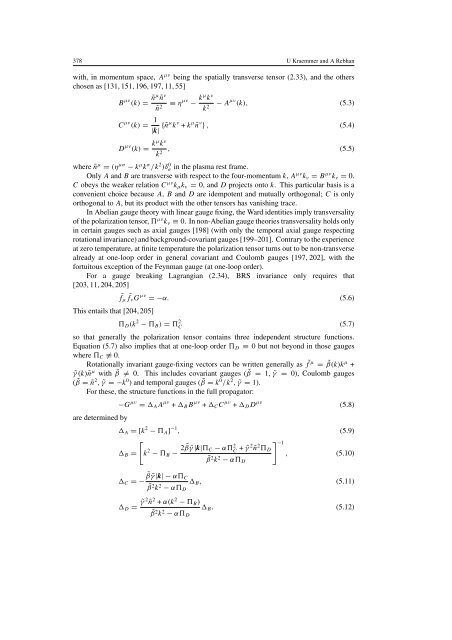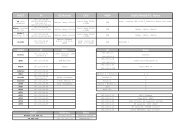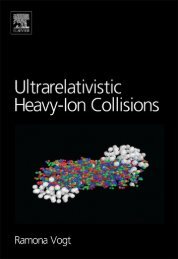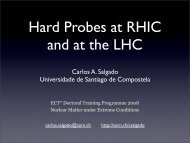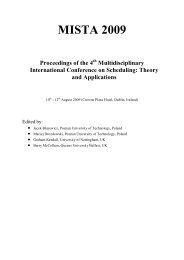Advances in perturbative thermal field theory - Ultra-relativistic ...
Advances in perturbative thermal field theory - Ultra-relativistic ...
Advances in perturbative thermal field theory - Ultra-relativistic ...
You also want an ePaper? Increase the reach of your titles
YUMPU automatically turns print PDFs into web optimized ePapers that Google loves.
378 U Kraemmer and A Rebhan<br />
with, <strong>in</strong> momentum space, A µν be<strong>in</strong>g the spatially transverse tensor (2.33), and the others<br />
chosen as [131, 151, 196, 197, 11, 55]<br />
B µν (k) = ñµ ñ ν<br />
≡ η µν − kµ k ν<br />
ñ 2<br />
k 2 − A µν (k), (5.3)<br />
C µν (k) = 1<br />
|k| {ñµ k ν + k µ ñ ν } , (5.4)<br />
D µν (k) = kµ k ν<br />
, (5.5)<br />
k 2<br />
where ñ µ = (η µσ − k µ k σ /k 2 )δσ 0 <strong>in</strong> the plasma rest frame.<br />
Only A and B are transverse with respect to the four-momentum k, A µν k ν = B µν k ν = 0.<br />
C obeys the weaker relation C µν k µ k ν = 0, and D projects onto k. This particular basis is a<br />
convenient choice because A, B and D are idempotent and mutually orthogonal; C is only<br />
orthogonal to A, but its product with the other tensors has vanish<strong>in</strong>g trace.<br />
In Abelian gauge <strong>theory</strong> with l<strong>in</strong>ear gauge fix<strong>in</strong>g, the Ward identities imply transversality<br />
of the polarization tensor, µν k ν ≡ 0. In non-Abelian gauge theories transversality holds only<br />
<strong>in</strong> certa<strong>in</strong> gauges such as axial gauges [198] (with only the temporal axial gauge respect<strong>in</strong>g<br />
rotational <strong>in</strong>variance) and background-covariant gauges [199–201]. Contrary to the experience<br />
at zero temperature, at f<strong>in</strong>ite temperature the polarization tensor turns out to be non-transverse<br />
already at one-loop order <strong>in</strong> general covariant and Coulomb gauges [197, 202], with the<br />
fortuitous exception of the Feynman gauge (at one-loop order).<br />
For a gauge break<strong>in</strong>g Lagrangian (2.34), BRS <strong>in</strong>variance only requires that<br />
[203, 11, 204, 205]<br />
f ˜ µ f˜<br />
ν G µν =−α. (5.6)<br />
This entails that [204, 205]<br />
D (k 2 − B ) = 2 C (5.7)<br />
so that generally the polarization tensor conta<strong>in</strong>s three <strong>in</strong>dependent structure functions.<br />
Equation (5.7) also implies that at one-loop order D ≡ 0 but not beyond <strong>in</strong> those gauges<br />
where C ≢ 0.<br />
Rotationally <strong>in</strong>variant gauge-fix<strong>in</strong>g vectors can be written generally as f ˜ µ = ˜β(k)k µ +<br />
˜γ(k)ñ µ with ˜β ≠ 0. This <strong>in</strong>cludes covariant gauges ( ˜β = 1, ˜γ = 0), Coulomb gauges<br />
( ˜β =ñ 2 , ˜γ =−k 0 ) and temporal gauges ( ˜β = k 0 /k 2 , ˜γ = 1).<br />
For these, the structure functions <strong>in</strong> the full propagator:<br />
−G µν = A A µν + B B µν + C C µν + D D µν (5.8)<br />
are determ<strong>in</strong>ed by<br />
A = [k 2 − A ] −1 , (5.9)<br />
[<br />
B = k 2 − B − 2 ˜β ˜γ |k| C − α 2 C + ˜γ ] −1 2 ñ 2 D<br />
, (5.10)<br />
˜β 2 k 2 − α D<br />
C =−˜β ˜γ |k|−α C<br />
˜β 2 k 2 − α D<br />
B , (5.11)<br />
D = ˜γ 2 ñ 2 + α(k 2 − B )<br />
˜β 2 k 2 − α D<br />
B . (5.12)


